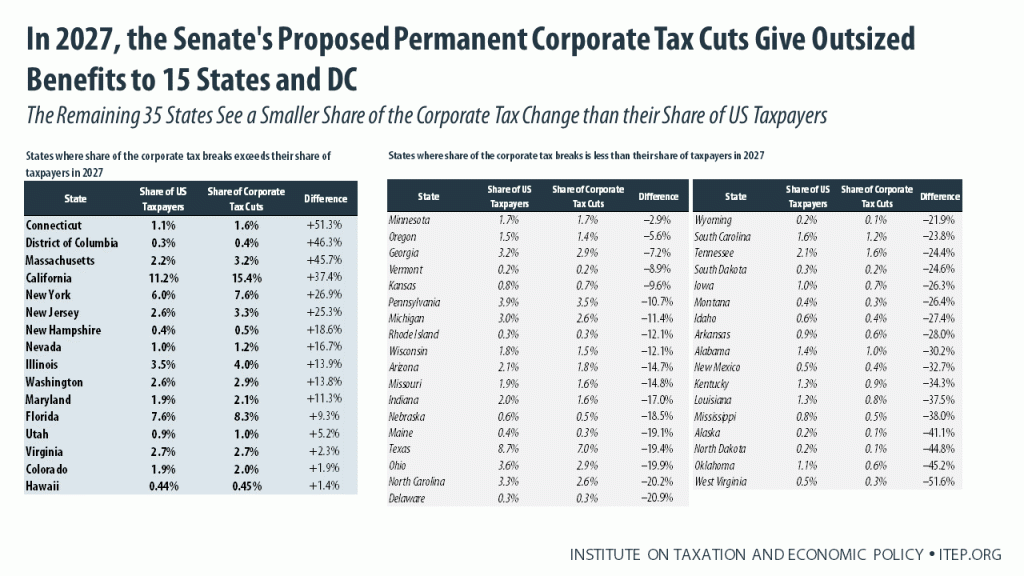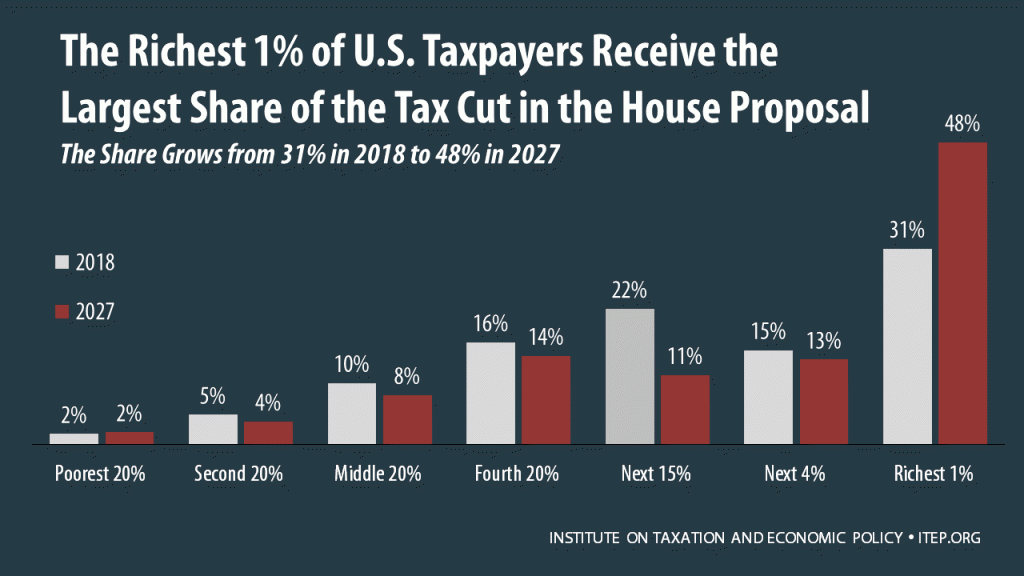The centerpiece of the House and Senate tax plans is a major tax cut for profitable corporations that the American public does not want, and that will overwhelmingly benefit a small number of wealthy investors living in traditionally “blue” states. New ITEP research shows that poorer states such as West Virginia, Oklahoma, Alabama, and Tennessee would be largely left behind by a corporate tax cut, while the lion’s share of the benefits would remain with a relatively small number of wealthy investors who tend to be concentrated in larger cities near the nation’s coasts.
Under a bill that the Senate is expected to vote on very soon, corporations would receive an $89 billion tax cut in 2019 alone. That includes $58 billion going to U.S. households (mostly to well-off households) and another $31 billion going to foreign investors in American corporations. The House bill includes similarly dramatic cuts for profitable corporations.
These cuts are shockingly unpopular, as just 9 percent of Americans believe that corporations pay too much in taxes today. Even in more conservative states, such as Arizona, that figure stands at only 18 percent.

In an effort to chip away at the unpopularity of a deep corporate tax cut, the Trump Administration and Congressional leaders have been selling the cut as a boon for workers. But the best available research suggests that workers won’t receive more than one-fourth of the overall benefits from this change, and even in the most optimistic scenarios it will take many years for those gains to trickle down to American workers. (Wealthier shareholders, by contrast, can expect a near immediate windfall.)
Most Americans understand that a lucrative tax cut for corporations won’t benefit truck drivers in Arizona, longshoremen in Maine, or factory workers in Tennessee in any meaningful way. Recent surveys have found that just 20 percent of Americans think a corporate tax cut will lead to higher wages. And a surprising number of CEOs have been willing to admit that shareholders will reap the rewards.
When most of the benefits remain with shareholders, as opposed to trickling down to American workers, that impacts the geographic distribution of a corporate tax cut in a big way.
For starters, foreign investors own about 35 percent of US stocks, so more than one-third of any benefit that remains with investors will be sent outside of the country’s borders.
Of the remaining share going to investors, much of the gain will be enjoyed by very-high-income investors living in places like Silicon Valley, Boston, New York City, and the Connecticut suburbs. These four states (California, Massachusetts, New York, and Connecticut) would receive larger benefits from a corporate tax cut than any other state, when measured relative to their number of households.
But those benefits would not be broadly shared. ITEP estimates that in 2027, 56 percent of New York’s corporate tax cut share, for instance, would go to just the top 1 percent of New Yorkers—even under the assumption that New York workers get one-fourth of the benefit. In both Connecticut and Massachusetts, the top 1 percent of earners would enjoy 52 percent of the benefit, while in California they would receive 46 percent.
At the other end of the spectrum, West Virginia would receive less benefit from a corporate tax cut than any other state, followed next by Oklahoma and North Dakota. Ironically, some of the biggest proponents of a corporate tax cut represent states with relatively low investment incomes and therefore little to gain from such a cut. Given this reality, and the overwhelming public opposition to a corporate tax cut, it’s a fair question whether the members of Congress pushing for a deep corporate tax reduction have the best interest of their constituents in mind.




